Fan palms are dramatic additions to our gardens, whether you choose to plant Australian Natives, Asian, or New World palms, they all thrive in our climate, and add light, bright privacy screens, or simple sculptural form to outdoor spaces.
Growing fan palms is relatively straightforward, but you’ll need to get your potting mix right for containerised plants, and potentially dig out and replace your earth if it’s not suitable for the specific variety.
More...
What are Fan Palms?
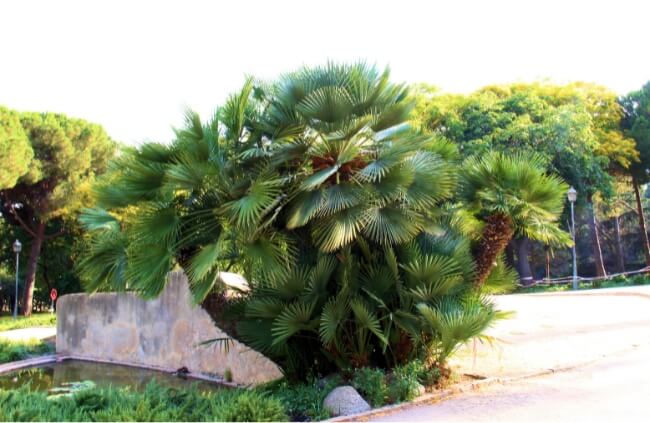
‘Fan palm’ refers to hundreds of species of plants in the Arecaceae family (palm family) across over a dozen genera, but the most common are Chamaerops humilis (European fan palm), Hyphaene petersiana (Real fan palm), Livistona (Chinese fan palm), Washingtonia (California fan palm or Mexican fan palm) and Latania (Indian Ocean fan palm).
They have distinctly different growth habits, some with a single trunk, others with multiple stems. Some grow to 20m tall, and others to around 2m at maturity. Even the textures of trunks and leaves can change, so it’s important to get to know the ins and outs of each type of fan palm and consider planting a few to bring textural interest and stepped heights to a border.
Different Species and Genera of Fan Palms
There are tons of fan palms dotted around the world and some that are synonymous with particular continents.
Some of the most common genera you can find for garden use include:
- Bismarckia
- Borassus
- Coccothrinax
- Copernicia
- Hyphaene
- Licuala
- Pritchardia
- Rhapidophyllum
- Rhapis
- Sabal
- Thrinax
- Trachycarpus
- Trithrinax
But there are five species in particular that seem to have stood the test of time as garden staples. We’ll talk more about each, and some of the others in more detail later in our list of the best fan palms to grow at home.
- Chamaerops humilis (European fan palm)
- Hyphaene petersiana (Real fan palm)
- Livistona (Chinese fan palm)
- Washingtonia (California fan palm, Mexican fan palm)
- Latania (Indian Ocean fan palms)
Fan Palm’s Natural Habitat
Fan palms are dotted all over the world, so it’s pretty much impossible to give an outline of what they all like, but… they generally prefer well-drained, deep, soils with loose structure that allows them to anchor themselves well and search for water well below the surface.
Every fan palm you can grow at home grows best outdoors, in full sun, like it would in nature, growing alone in open space, either near coasts, or in exposed landscapes.
Their tough leaves are well adapted to cope with winds, particularly coastal species.

Australian Fan Palms
Licuala ramsayi is the most common Australian fan palm, but there are several varieties, and other species in the same family dotted across the country. It grows in rainforests and develops rapidly whenever there are openings in the canopy above.
New World Fan Palms
Washingtonia is a small genus of fan palms that grow natively in southern America and Mexico. They are the most synonymous with the region but by no means the only fan palms in the Americas.
However, they offer an insight into the generic native habitats of these New World Fan Palms, which are; open spaces, good drainage, full sun, and enough space to reach a mature height of nearly 30m.
Asian Fan Palms
Livistona, the Chinese fan palm, despite its name, is one of the most widespread genera of Arecaceae, found throughout south and southeastern Asia, Australia, and parts of Northern Africa.


Get Your Free Guide:
Master Growing Australian Natives eBook
A Must Have Complete Guide for Every Australian Garden
Get Your Free Guide:
Master Growing Australian Natives eBook
A Must Have Complete Guide for Every Australian Garden
They grow in most soils but require good drainage to establish well, reaching heights of up to 35m. Like most species of fan palm native to Asia, they grow in colonies, often creating entire forests of a single species of tree.
European Fan Palms
European fan palms are nearly entirely native to the Mediterranean, where they enjoy exposed coastal winds, warm summers, and relatively dry winters. They are more cold-hardy than most and can cope easily in cooler parts of Australia through winter without any worry.
Sandy, gritty, or gravelly soils are a must for these Mediterranean fan palms to thrive.
African Fan Palms
There are many fan palms native to Africa but the most synonymous is the ‘real fan palm’, spread across subtropical and central Africa, where it grows on rich but dry soils in open landscapes.
They require loose soil structure and have incredibly tough tap roots, so should not be planted near underground structures or pipe work.
12 Popular Fan Palm Varieties to Choose From
1. European fan palm (Chamaerops humilis)

The European Fan Palm (Chamaerops humilis) is a Mediterranean native, and is great for cooler climates and hardy right down past freezing.
This dwarf variety is simple to grow and while the trunks take time to establish, you’ll get most of the tropical effect from its huge leaves after a couple of years, making this one of the fastest fan palms to establish in any garden.
2. Real fan palm (Hyphaene petersiana)

Sometimes called Makalani Palm, Hyphaene petersiana is a tall, upright fan palm that develops a loose canopy of massive fan-shaped leaves on a single stem. However, it can be grown as a multi stemmed tree, of tight clusters, where each tree will restrict the growth of the next.
It’s one of the few single-stemmed fan palms that’s reasonably suited to small gardens as it generally only reaches about 8m tall if planted in open space - but is capable of 18m if it has competition from other trees.
3. Chinese fan palm (Livistona chinensis)
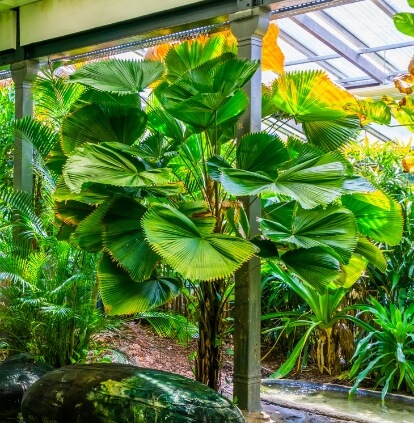
Livistona, the Chinese fan palm, can reach 20m tall, but most species are actually quite dwarfed, and well suited to container planting, which will restrict their growth, and even allow them to be grown indoors.
Mature Chinese fan palms, depending on species, have foliage that can be 6ft by 5ft so make great statement palms.
4. California fan palm, Mexican fan palm (Washingtonia)

Washingtonia is a varied genus, with many smaller cultivars, but the iconic Washingtonias of southern North America reach vast heights very quickly.
If you want to grow washingtonia for its more formal, and tidy trunks, make sure to choose one with a limited mature height.
5. Indian Ocean fan palms (Latania)
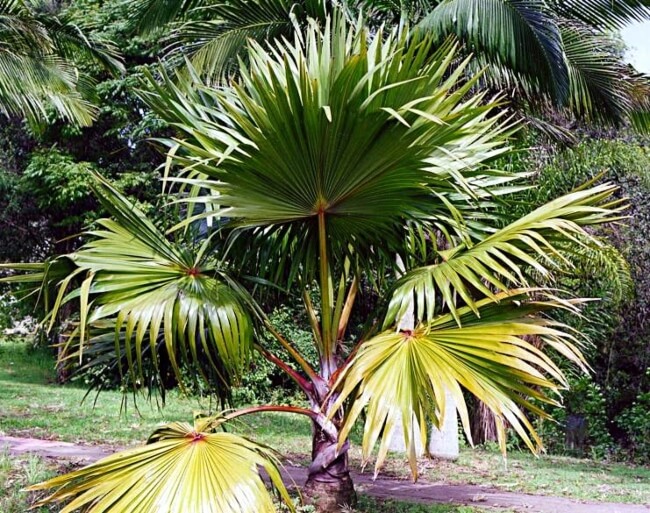
Source: Pacsoa
Indian Ocean fan palms are a genus of just three species, each found growing native on the separate Mascarene Islands. They are all endangered in the wild, but responsibly cultivated forms of each can be found for garden use and even as house plants, as they, like most fan palms, can be restricted in containers with good effect.
6. Copernicia

Most species of Copernicia fan palms are native to Cuba, but all are found in South America and the Caribbean. Some species grow to just 5m tall, making them ideal for garden cultivation, while others, at over 30m, are best suited to large landscape gardens and public spaces.
Most species of Copernicia have stunningly uniform stems, but some, including Copernicia macroglossa hold old leaves in a dense blanket extending right down to the ground. These leaves can be removed to improve appearance without harming the tree.
7. Licuala ramsayi

Source: Oxley Nursery
A more unusual fan palm, that holds its form, and offers an almost 350-degree leaf spread, is the Australian fan palm (Licuala ramsayi).
It’s native to Queensland, and will grow to around 10m tall if planted in the ground, or 5m in containers, often grown as a houseplant in restricting pots. Their foliage is highly structural but with a translucency that allows light to pour through its canopy, weaving distinctive shadows on the ground below.
8. Rhapis

Rhapis is a common genus traded as houseplants, native to Southeast Asia. They can grow rapidly, but are generally quite short fan palms if grown in full sun.
While they are generally considered fan palms, they have fairly plain foliage with deep separations between the leaflets.
9. Sabal
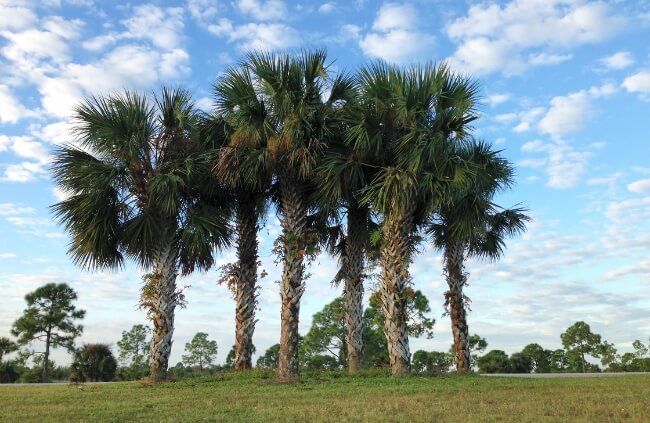
Sabal are all native to warmer regions of southern North America down to South America, and can all be grown here in Australia with relative ease. Their thick trunks drop old leaves quite evenly, meaning they retain an attractive form for most of the year, and are generally pretty easy to care for.
Their large fan leaves are firm, with quite sharp tips, but rustle in the breeze like paper. If you want something reliable for your garden, Sabal fan palms are a great choice.
10. Thrinax

Source: PalmPedia
Thrinax are beautiful Carribean fan palms, with unusually dense foliage that tends to connect at the base of each leaf, forming more solid foliage than nearly any other genera of fan palm.
The impact is more effective shade, and a generally neater tree, that will grow happily on any soil with reasonable drainage.
11. Hyphaene

If you like the idea of taller fan palms, but are worried about height, or towering single stems, consider Hyphaene. They are native to Africa and the Middle East, and grow naturally on multiple stems, offering a more fluid structure than most fan palms.
The other benefit of that is that they can be pruned with great success to remove more vigorous branches and replace them with new growth.
12. Bismarckia

Bismarckia is a genus with just a single type. Its striking silver fan leaves are unlike any other palm, and are only found growing natively in western and northern Madagascar.
It grows in open grassland in full sun, and with strong tolerance to wind and salt exposure, even thriving on relatively poor soil. Bismarckia is hardy down to -4°C as well as being very drought tolerant, so works well in most Australian gardens, though it can reach up to 21m tall.
How to Grow Fan Palms in Australia
Ideal Conditions for Planting Fan Palms
Fan palms are simple to grow, but do keep in mind that this guide needs tweaking slightly depending on the variety of fan palms you want to grow.
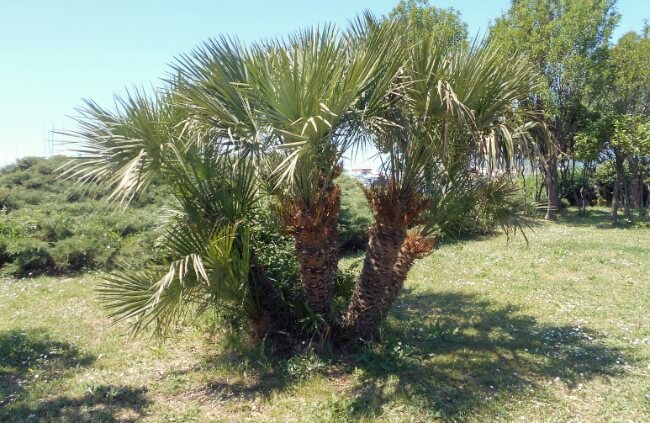
Soil & Drainage
As a general rule, there are no (or very few) fan palms that like damp conditions, and the vast majority need very good drainage and open soil, so adding sand, grit or gravel to their soil is a must.
Some species like richer soils, so mix through compost with the rest of the mix and make sure there’s some good top soil in there for anchorage too.
Light
Fan palms need plenty of sunlight. Cuttings or seedlings can be protected to support their development, with bright shaded conditions, but any mature or semi-mature tree should be given full sun throughout the day.
Space requirements
Fan palms can grow into very large trees. Most garden species reach a maximum height of 4-5m tall, but some are towering specimens that won’t just define your own garden, but be visible for miles when they mature.
For landscape planting, fan palms look best planted in numbers but with loose spacing, or as a very formal lining to footpaths. In private gardens, mix other planting around their base, and stick to tropical rainforest species or smaller varieties that will work in a mixed border.
Water
Like any tree or shrub, fan palms need water when they’re first planted, and for the first summer, should be watered with a full bucket at least once a week to support developing roots, and make sure there is proper connection to their substrate.
As they develop, ignore watering altogether and let them adapt to their setting.
Growing Fan Palms in Pots
Fan palms can be planted in pots, but choose your cultivar wisely. Pots restrict growth, but not completely, so fan palms should either be root-pruned or potted on every 3-4 years. Use a potting mix similar to the one described above.
Growing Fan Palms in the Ground
The best planting situation for any fan palm is open ground, with no competition for the first couple of years. Prepare your soil as described above, and stake more mature fan palms to limit rocking in the wind until roots are established (three years as a rule).
After planting, water well, and mulch with bark chips to keep the base of the plant tidy until it establishes. After that, you can go wild with gorgeous planting around the base, and non-invasive climbers like clematis or passion fruit vines grow up the trunk.
How to Propagate Fan Palms
There are three reliable ways to propagate fan palms; seed, air layering, and pups. Choosing which to use depends on what materials you have available, the species, and the time of year.
Propagating Fan Palms from Seed
Fan palm seeds are large, usually about the size of a tennis ball, with a hard shell. The end of the shell will have a softer section, which can be soaked to encourage growth, or simply left to the elements.
However, for best results, gently sanding the end of the shell, and then soaking it for 24 hours will encourage new life. Then just pop the whole seed into a pot filled with peat-free compost so that half the seed is buried, and the softer part sits level with the soil.
Germination can take several months, so be patient, but growth is rapid after that.

How to Propagate Fan Palms from Air Layering
Air layering works on some palms, but not on others. Single-stemmed fan palms can’t be air layered, but multi-stemmed fan palms with new growth are excellent candidates for air layering.
All you need to do is wrap some moss, or even compost around a young stem before its bark or casing if fully hardened.
- In spring, make a small v-shaped groove in the branch to reveal the green layer beneath.
- Wrap it in moss or damp compost, secure in place with plastic film, and fasten tightly with water-proof tape.
- The cut section will send out roots after a week or so but wait until the end of summer, when roots should have filled the plastic casing.
- Don’t worry about watering, or misting, as the rooting section will still be drawing moisture from the parent plant.
- At the end of summer, peel away the plastic covering, and there will be plenty of new, thick, roots, wrapped around the compost or moss.
- Cut just below the new roots with a clean saw, and plant it straight into a fresh pot of compost.
- When the roots fill that pot, it’s ready to plant out in the garden.
Fan Palms Propagation from Pups
Pups are the easiest way to propagate new fan palms, but not all species produce them. Pups are the small plants growing alongside the parent plant, from a newly developed section of root. Fan palms with fleshy roots, and mostly multi-stemmed stems, are most likely to offer pups.
Propagating fan palm pups is as simple as digging them up (carefully) with as much root as possible and planting them in a new pot to develop away from the parent. Keep the pup in a bright, warm spot, away from direct sunlight, and in a few months’ time it should have rooted well, along with plenty of new growth.
Caring for Fan Palms
It’s easy to care for established fan palms, as they are largely drought tolerant, and any variety you buy in Australian garden centres will be hardy through our winters.
In colder parts of the country, it’s worth wrapping the trunks, and any bare crowns in horticultural fleece if there is a risk of frost, but other than that there’s nothing complicated to do at all.
Mulching Needs
Fan palms don’t need mulch, but young and newly planted fan palms can be tidied up with a layer of bark mulch or stones around their base while they establish.
Once established, you can either continue mulching for decoration or plant around the base to add more interest to your border.
Recommended Fertiliser for Fan Palm
Nitrogen and potassium are key nutrients for fan palms. Phosphorus is useful in limited amounts. Rather than stressing over what fertiliser to buy, just go for a standard shop-bought fan palm feed, which can be used once a year as a slow-release supplement if required.
Healthy fan palms on reasonably nutritious, free-draining soil, shouldn’t need any fertiliser, so this only needs to be added if there are signs of nutrient deficiency, like yellowing leaves, dropping leaves, or very slow growth (such as no new leaves).
Pruning Fan Palms
Fan palms don’t need to be pruned at all, and some single-stem species won’t grow back if pruned. Unless there is an absolute need to prune a fan palm, either because it is growing over a fence, or has clear signs of fungal disease on one stem, leave them alone.
If you must prune your fan palm, use a clean pruning saw, making an initial incision on the underside of the branch to halfway, and cutting from above to meet it. This prevents tearing, and will leave a cut that the tree can heal more easily.
Repotting Fan Palms
As mentioned earlier, some fan palms have vigorous roots, which means potted fan palms do either need root pruning, or potting up at least every five years.
To restrict growth, and maintain health in the same pot every time, remove the tree from its container, and shake off any outside soil and compost. Using clean secateurs, cut about 1 to 2 inches of root away from the edge of the pot, then replant it with a fresh potting mix around the edge.
This promotes healthy new roots that can take up nutrients and water, and limits the development of the tree, similar to, but not as extreme as bonsai.
Common Fan Palm Pests and Diseases
Palms have quite a few common pests around Australia, including some that you might not think were capable of damaging these tough-leaved plants. Diseases are less common, but excessive pest damage can harm trees, and problems with damp or overly humid crowns can kill fan palms.
However, it’s always possible to fix problems with fan palms, so follow the guides below.
Palm mites
Palm mites, or red palm mites, are problematic in all parts of Australia, but particularly common around Queensland. They are absolutely miniscule pests, and very hard to spot, but if you look up close they are quite distinctive, with red bodies, black markings, and sticky hairs across their back.
They make small bites all over palm leaves, creating even yellow discoloration that starts around the midrib and fades outward. They can be treated with neem oil or horticultural soap, which will help to prevent fungal infections too.
Caterpillars
Caterpillars that affect fan palms are generally leaf-boring types, which live inside the thin structure, and create channels of translucent foliage with a dusty coating.
There is no way to get rid of them without discarding and burning the leaves they are in, so fast action is required if you notice their distinctive patterns to limit damage to new growth.
Red scale
Red scale can be found around the main leaf stems, and can develop into heavy infestations very quickly. The small red insects cover themselves in waxy secretions, making the plant look like it’s been covered in dough.
Leaves will generally show uneven yellow markings in the early stages, and heavy infestations can cause complete leaf drop across entire plants. Removal requires organic insecticides, otherwise, their secretions can block photosynthesis and permanently kill the plant.
Spiralling whitefly
The longer spiralling whiteflies are present on palms, the harder they are to identify, as they coat leaves in powdery droppings that block photosynthesis.
Damage tends to be even weakening of leaves, resulting in pale, greyish-yellow foliage. In the early stages, they instinctively eat in neat spirals, creating gorgeous patterns on fan palm leaves.
They can be blasted off with a strong water jet, or treated with organic insecticides. Wiping them off leaves with a soapy cloth when there are just a few present will limit the problem too.
Weevils
Weevils can cause leaf drop, or damage roots, depending on the type. Introducing beneficial nematodes around the base of palms can help to prevent root damage, but it’s very hard to manage weevil infestation at the crown of a plant.
When weevils infest fan palm crowns, their grubs are laid into holds at the base of leaves. When they drop, the leaf will look almost composted at the end. Treatment is very difficult, particularly with taller fan palms, but neem can work as a preventative.
Fan palms can be affected by blights, fungal rot, and root damage, and some problems will occur regardless of care.
Blights
Blights are very challenging to manage, and produce grey-brown discolouration, often with no significant markings. The most common is petiole blight, which begins at the base of a leaf stem, and spreads to the entire leaf until it simply falls off.
To minimise these problems, make sure any fan palm you plant is given free draining soil, and any mulch is kept at least 15cm away from the trunk to reduce humidity and moisture against plant tissues.
Nitrogen feeds can help in some cases, even after infection, as they boost new growth and support natural responses to disease.
Fan Palm Frequently Asked Questions
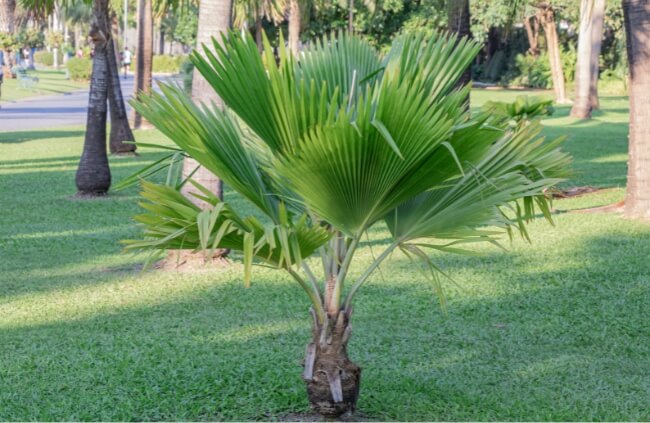
How quickly do fan palms grow?
Most fan palms grow about 1m per year until they begin to reach maturity. When the main stems develop hard skins or barks, they tend to slow down a little, but can still grow 30-60cm per year.
Are fan palms evergreen?
Most fan palms are evergreen, replacing older leaves with new leaves in late spring, and holding onto mature leaves through winter.
Can you grow fan palms on clay?
Fan palms can grow perfectly well on clay soils, provided there is adequate drainage mixed through the topsoil.
What is the lifespan of a fan palm?
Fan palms live for over 100 years, with some reported to be over 600 years old in their native habitat.
What happens if you cut the top off a fan palm?
If you cut the top of a fan palm it won’t grow back. Some species which grow as multi-stemmed types can develop new branches from nodes that protrude from old stems, but they won’t shoot off into two new branches like most plants would.
Wrapping Up Our Guide to Fan Palms
Fan palms are majestic trees, and they bring brightness and vigour to any garden that’s lucky enough to be graced by them. Planting your own needn’t be a stress, just make sure you choose the right fan palm for the right place, and check for signs of pest problems once in a while.
If you give your trees just a little bit of attention you’ll be growing fan palms that are the envy of the neighbourhood in no time.
Published on October 4, 2023 by Maisie Blevins
Last Updated on January 24, 2025




